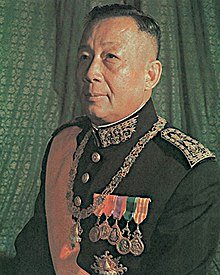Lao King Story
King Sisavangvong died in 1959 and was succeeded by his son, Sisavang Wattana. For the coronation ceremony, the crown prince enlarged the throne room by adding two equal-sized rooms, one on each side. He commissioned a mosaic decoration on the interior walls and modernized the whole compound. The latter included rearrangement of the partition walls in the residence area, installation of new ceilings, renovation of electrical installations, and the construction of a new building for large receptions.
However, the establishment of the Lao People’s Democratic Republic on 2 December 1975 prevented the coronation from taking place. The king abdicated and was appointed Supreme adviser to the president. On his return to Luang Prabang, he moved to his private residence close to Xiengthong temple and offered that the palace could be converted into a national museum, the main aims of which are to preserve the palace and the royal collection and inform the public of the history of the former monarchy.
Today, the National Museum is among the best places to learn about the history of Luang Prabang.
The Prabang has been a chief source of spiritual protection for Lao since it was brought from Cambodia in the 14th century. According to legend it was made from pure gold In India, and then presented to the king of Sri Lanka and subsequently to the king of Cambodia. Eventually, king Fa Ngum, founder of the kingdom of Lane Xang, obtained it through his wife, who was a daughter of the king of Cambodia.
The Prabang is now housed in a temple in the right-hand corner of the palace grounds on entering the main gate. The room contains stone statues of Buddha from the 12th century, among offerings and other objects associated with the Prabang.
One of the best places to see traditional dance in Laos is at the Phralak Phralam Theatre on the grounds of the National Museum. There, four times a week, dancers, accompanied by a live orchestra, perform the episodes of the Ramakien, or the Lao Ramayana.
The Ramayana, popular throughout South and Southeast Asia, was first brought to Luang Prabang centuries ago by Buddhist missions. Since that time, the story has taken on a distinctively Lao style and is most popular in dance. The long traditions of the music and the performance persisted through the 20th century in Laos, as dancers, musicians, and artists continued to play the scenes outdoors on a variety of special occasions and as a part of annual Pi Mai (Lao New Year) celebrations.
In 2003, the Phralak Phralam Theatre was established by the Lao PDR with the cooperation and support of the international community, ensuring the survival of the Lao Ramayana and giving visitors and Lao people alike the opportunity to experience this vitally important part of Lao culture.
For more information about performance schedules and the story of the Lao Ramayana, visit the Phralak Phralam website.

Hi! I am a robot. I just upvoted you! I found similar content that readers might be interested in:
http://tourismluangprabang.org/things-to-do/culture-and-history/national-museum/